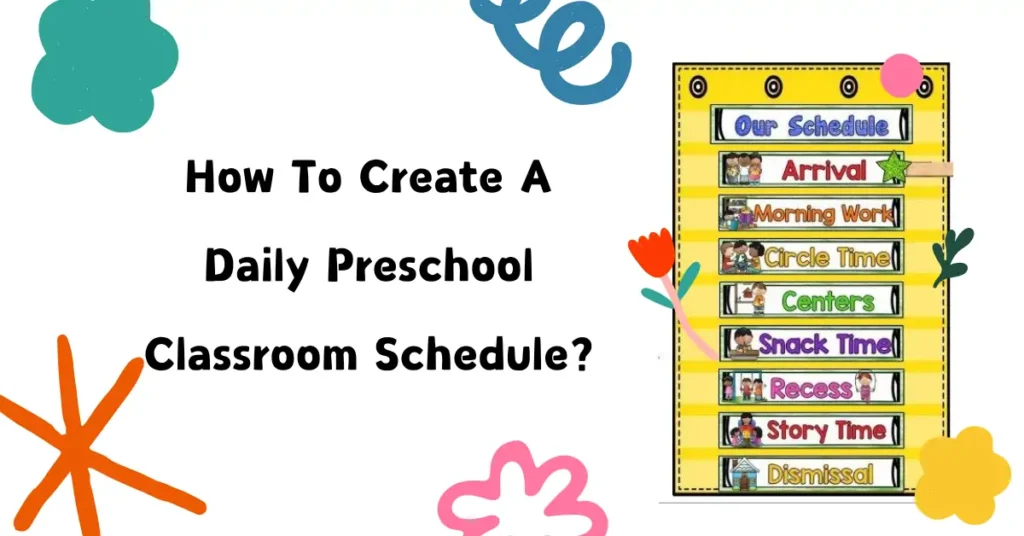As an educator, you understand the importance of structure and routine in the lives of young children. A well-planned preschool classroom schedule not only helps children feel secure, but also supports their overall development and learning.
A well-crafted preschool classroom schedule balances structured activities with free play, includes time for meals, rest, and outdoor play, and considers the attention span and interests of preschool-aged children. It’s crucial to create a rhythm that feels natural, allows for flexibility, and supports the educational goals of the preschool program.
Whether you’re a seasoned kindergarten teacher looking to modify your preschool classroom schedule or a new educator curious about best practices, this article is your go-to resource for creating a daily schedule for your preschool classroom that will prepare your students for success.
So let’s get started on designing a preschool classroom schedule that will make every day in your preschool classroom meaningful and enjoyable for you and your children.
Elements of an Effective Preschool Classroom Schedule
In the bustling world of a preschool classroom, where laughter fills the air and curiosity leads the way, the structure is silently at the helm, guiding both educators and young learners through a sea of endless possibilities. It’s the rhythm of the day that brings a sense of security and belonging to children, allowing them to explore, learn, and grow in a nurturing environment. Yet, how do we craft this rhythm to ensure it resonates with the needs of every child?
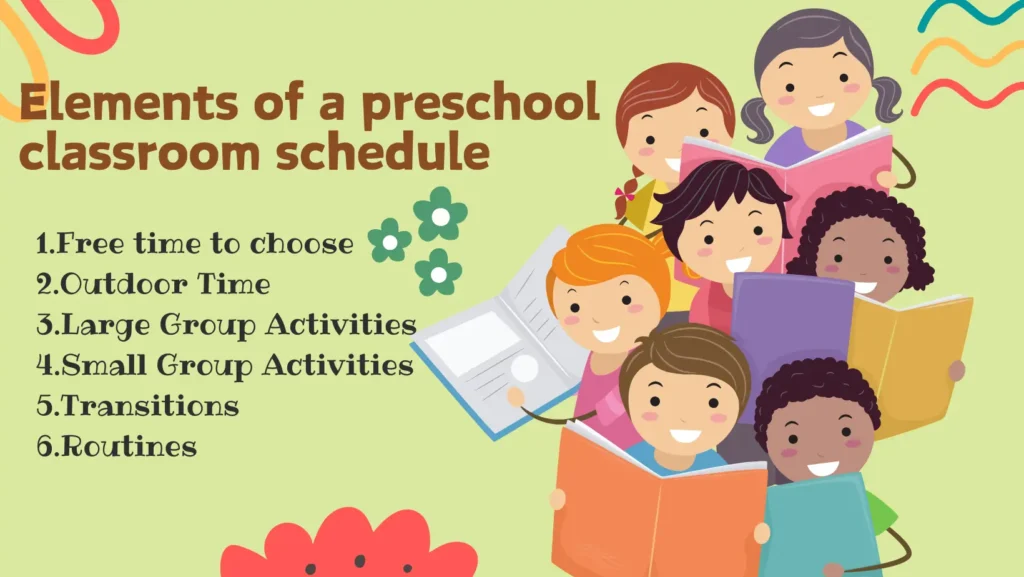
There are six elements of an effective preschool classroom schedule:
- Free time to choose
- Outdoor Time
- Large Group Activities
- Small Group Activities
- Transitions
- Routines
Free time to choose
Free choice time is when children can choose for themselves which activities they want to participate in during the school day. During free-choice time, children are given the autonomy to choose activities that interest them. Children need many opportunities to engage in play and follow their interests. Children will share, negotiate and collaborate with their peers. This is an opportunity for educators to observe and guide children’s learning according to their interests, adapting the environment and materials to challenge and further engage them. Free-choice time should be enriched to allow children to delve into their projects and play deeply.
Outdoor Time
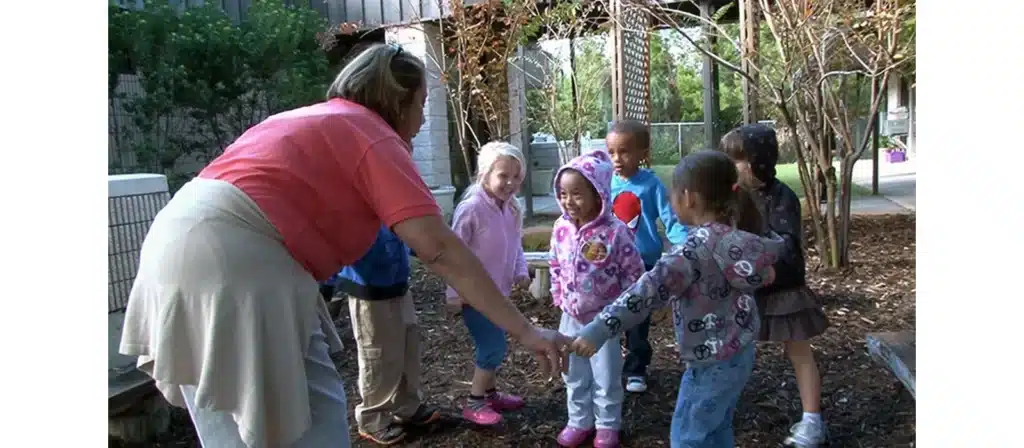
Outdoor play is more than a break from the classroom; it is an important part of children’s physical and mental health. It encourages physical fitness, creativity and problem-solving skills as children interact with nature and outdoor play equipment. This time should include free play and guided activities that allow children to explore their environment, allowing children to direct their own play and learning and follow their own interests. Adventure in a safe environment and learning about the natural world.
Research shows that children who spend more time outdoors are more physically active and therefore less likely to have future health problems. Weather permitting, spend at least 60 minutes a day outdoors. In a full-day program, this time should be spent outdoors in both the morning and afternoon. Outdoor time can take different forms. Specialized outdoor playground areas can be constructed in preschools, or traditional outdoor play activities can be used.
Large Group Activities
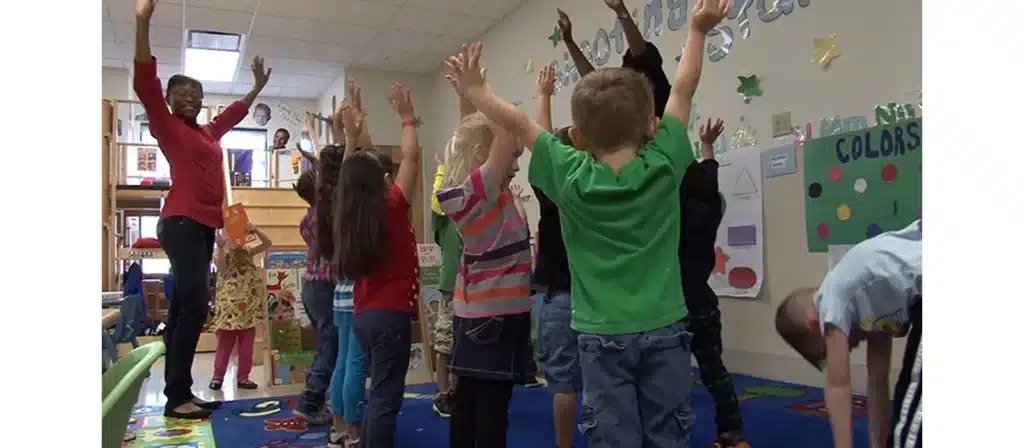
Large group activities are designed to foster a sense of community and cooperation among children. This time can be used for interactive storytelling, music and movement, group games, or discussions that promote language development and social skills. This is a time for children to practice listening, taking turns, and expressing their ideas in a large group setting, preparing them for more formal learning environments in the future.
Small Group Activities
Group activities allow for more targeted skill development and individual attention by educators. They can focus on specific educational goals, such as math concepts, literacy skills, or science experiments, tailored to children’s developmental levels and interests. These types of activities are well suited to promote active participation by children. Group settings encourage children to engage more deeply, ask questions, and explore concepts under the guidance of the teacher.
Transitions
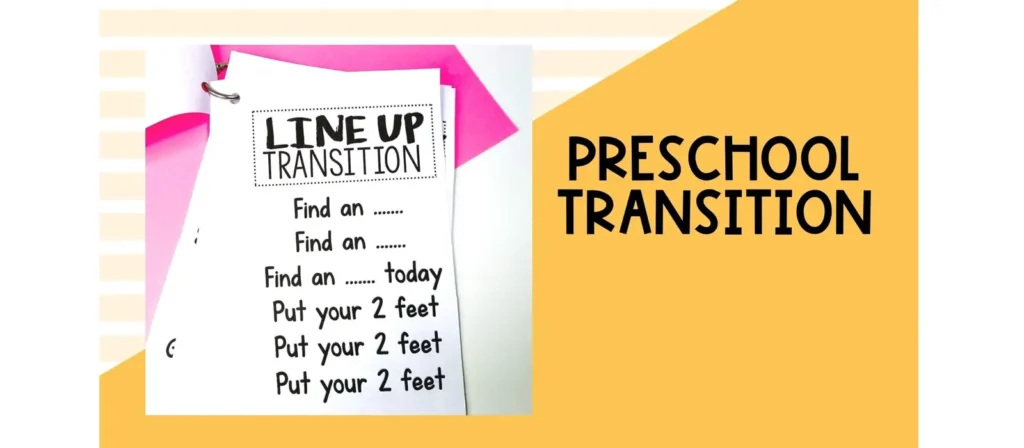
Transitions between activities are often overlooked. Effective transitions are smooth and engaging, minimizing downtime and behavioral issues. Transitions are often a difficult part of preschool, during which children may be less engaged. While some transitions are necessary, teachers can do their best to minimize transitions and keep children engaged. Strategies such as songs, games, or consistent routines can turn transitions themselves into learning opportunities that teach children about sequence, time management, and following directions.
Routines
Routines provide structure to the day and provide children with the predictability and security they need to feel safe and focused. Routines should include scheduled times for meals, rest and hygiene practices. Planning is the key to a successful routine and routines should be appropriate for the child’s developmental stage. Establishing and maintaining these routines helps develop self-care skills, time management, and responsibility in young learners.
What is a visual schedule for preschool?
A visual preschool classroom schedule for preschool is more than just a timetable; it’s a visual communication tool that depicts the sequence of activities planned for the day. It uses pictures, symbols, and words to represent different parts of the day, making it accessible and understandable for young children, regardless of their reading ability.
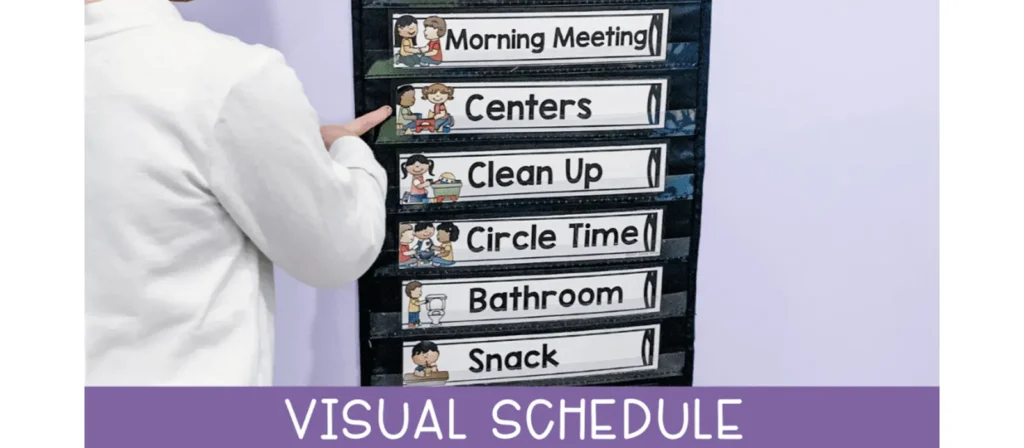
Visual schedules serve several pivotal roles in the preschool environment. Firstly, they help children understand the flow of their day, reducing anxiety and building a sense of security. Seeing what comes next allows children to prepare mentally and emotionally for transitions, fostering independence as they begin to anticipate and look forward to upcoming activities.
Even in these early stages, children learn the concept of time and sequence, understanding that their day is divided into different segments for various activities. This early exposure to time management is invaluable, laying the groundwork for essential life skills.
Incorporating visual schedules into the classroom also supports children with special needs. For children on the autism spectrum or those with communication challenges, visual schedules are a lifeline, offering a clear, predictable structure that helps navigate the day with less stress.
Benefits of a Visual Schedule
The introduction of a visual preschool classroom schedule into the preschool classroom brings a multitude of benefits, significantly impacting both teachers and students. Here are some key advantages:
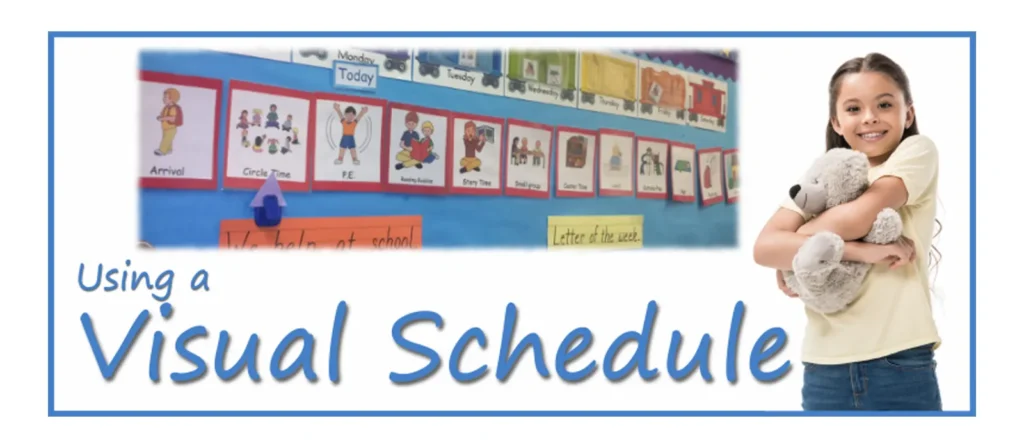
- Enhanced Understanding and Participation: Visual schedules demystify the day’s structure for young learners, promoting active participation. When children understand what’s expected, they’re more likely to engage positively with each activity.
- Reduced Anxiety and Behavioral Issues: The predictability provided by visual schedules can greatly reduce anxiety among preschoolers. Knowing what to expect helps children feel secure, which in turn minimizes behavioral issues related to uncertainty or resistance to transitions.
- Support for Diverse Learning Needs: Visual schedules are particularly beneficial for children with special needs, offering a clear and consistent structure that can help them navigate their day more easily. This inclusivity enriches the classroom environment, ensuring all children have the support they need to thrive.
- Development of Independence and Self-Confidence: As children learn to follow the visual schedule, they develop independence. This self-guided navigation through their day fosters a strong sense of achievement and self-confidence.
- Facilitation of Smooth Transitions: Transition times between activities can often be chaotic. A visual schedule provides clear signals for transitions, helping children move smoothly from one activity to another without confusion.
Designing an Effective Preschool Classroom Schedule
Designing an effective preschool classroom schedule requires a thoughtful balance of activities that meet the developmental needs of young learners. The following are key considerations for developing a schedule that promotes learning, play, and rest:
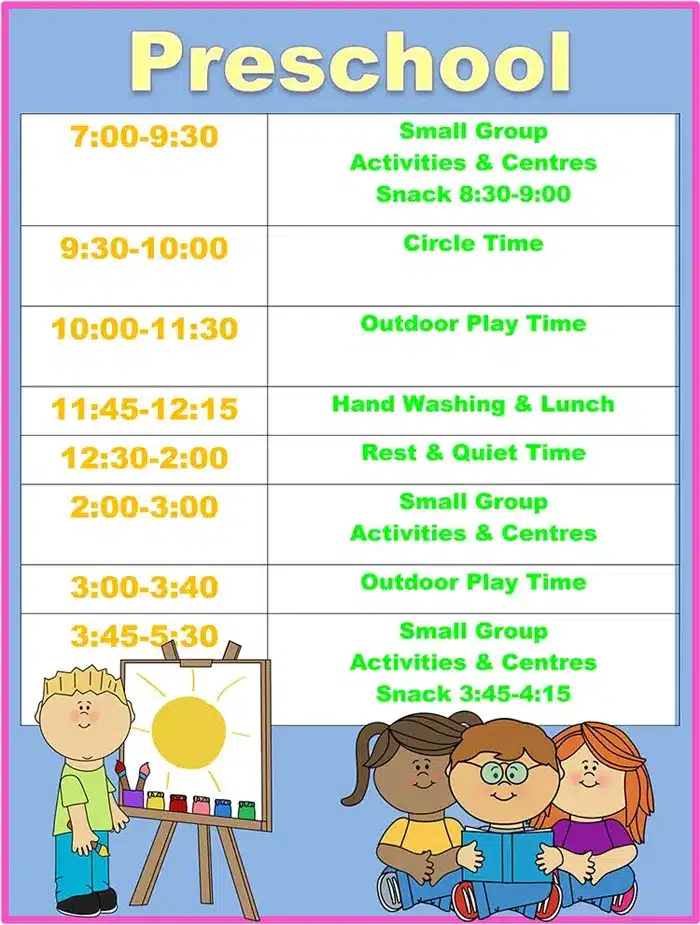
- Start with a warm welcome: begin the day with a welcoming routine that makes every child feel valued and included. This can be a circle time where you sing a good morning song, discuss the day’s weather, or share the news. This sets a positive tone for the day.
- Be consistent but flexible: while consistency is key to providing structure, flexibility allows you to be responsive to the needs of the day. Perhaps an activity appeals to a child’s interest more than expected, or they need more outdoor time on a sunny day.
- Provision of free choice time: A minimum of 60 minutes of free choice time is scheduled every day, allowing children to choose activities according to their interests. This not only enhances their autonomy but also promotes deeper learning.
- Scheduling outdoor activities: Ensure that at least 60 minutes of outdoor time is scheduled each day to promote physical health and social skill development. The outdoor environment should provide areas of interest similar to those indoors to encourage children to explore the natural world.
- Controlling the length of large and small group activities: Limit the total length of large and small group activities to 15-20 minutes to keep children’s attention and interest.
- Keep children engaged during transitions: Transitions are the times when problem behaviors are most likely to occur. By engaging children in meaningful tasks, such as helping to organize toys, you can reduce the angst and boredom of waiting time.
- Provide advance warning of transitions: Use auditory or visual cues, such as countdowns or songs, to notify children in advance of upcoming transitions and help them prepare.
- Incorporate movement and music: By incorporating movement and music into daily routines and transitions, such as singing, dancing, or mimicking animal behaviors, you can add fun and increase children’s engagement.
- Flexibility in adjusting daily schedules: While the predictability of routines is important for kids to feel safe, flexibility is just as critical. If planned activities aren’t working, it’s worth reconsidering and adjusting.
- Communicate the schedule: use a visual schedule to communicate the day’s routines to your kids. Viewing schedules at the beginning of the day and before transitions can help kids feel secure and prepared for what comes next.
Adjust Timetables for Different Age Groups
Different age groups have different needs, attention spans, and energy levels, which should be reflected in the preschool classroom schedule:
- Toddlers (Ages 2-3): For younger children, preschool classroom schedules should allow for greater flexibility. Activities should be shorter to match their attention span, interspersed with plenty of free play and nap time.
- Preschoolers (Ages 4-5): Older preschoolers can handle longer periods of structured activity but still require a balance of free play, physical activity, and rest. Their schedule can include more complex activities geared towards kindergarten readiness.
Half Day Schedule Example
A half-day preschool program typically runs for about 3-4 hours. Here’s an example of how you might structure a morning:
- 8:00-8:30 – Arrival and Free Play
- 8:30-8:45 – Circle Time (Welcome, Songs, and Day Overview)
- 8:45-9:15 – Structured Learning Activity (Literacy or Math)
- 9:15-9:45 – Snack and Story Time
- 9:45-10:15 – Outdoor Play
- 10:15-10:45 – Creative Arts and Crafts
- 10:45-11:00 – Closing Circle Time (Review of the Day, Preparing for Home)
Example of a Full Day Schedule
A full-day preschool classroom schedule accommodates a wider range of activities and rest periods. Here’s a sample schedule:
- 8:00-8:30 – Arrival and Free Play
- 8:30-9:00 – Circle Time
- 9:00-9:30 – Structured Learning Activity
- 9:30-10:00 – Snack and Story Time
- 10:00-10:30 – Outdoor Play
- 10:30-11:00 – Creative Arts
- 11:00-11:30 – Free Play or Small Group Activities
- 11:30-12:00 – Lunch
- 12:00-12:30 – Quiet Reading or Rest Activities
- 12:30-2:00 – Nap Time or Quiet Rest
- 2:00-2:30 – Snack and Free Play
- 2:30-3:00 – Science or Sensory Activity
- 3:00-3:30 – Outdoor Play
- 3:30-4:00 – Closing Activities and Preparation for Departure
In conclusion, crafting a daily preschool classroom schedule that effectively balances educational goals, developmental needs, and the interests of young children requires thoughtful planning and flexibility. By incorporating a variety of activities, including ample time for play and rest, educators can create a nurturing environment that fosters learning, development, and joy in their preschoolers.

